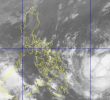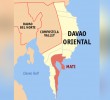by JOHN RIZLE L. SALIGUMBA
Davao Today
MATI, Davao Oriental — “Today is my birthday but here we are, away from home. The sound of the waves is scary, that’s why we had to leave,” said Maria Duayna, 51, whose family was among the 120 households that fled Barangay Lawigan, the farthest fishing village here.
Duayna and the other residents of Bagong Lipunan, Bayanihan, Malipayon, Bagong Silang, Dama de Noche and Malantawon, all villages of Barangay Lawigan, have fled after “unusual high tides” and heavy rains came with tropical depression Agaton.
Duayna said although village officials gave them advance notice, they still left their village with little preparation.
Constant rains in the last few days have caused several flooding and landslides here that killed nine and injured many.
Fisherfolks here also said they have no plans of going off to sea as waves have been higher than usual. They, however, said they won’t abandon their fishing boats.
“These waves aren’t normal, it is not safe for anyone to go out to sea so we decided that our families evacuate. But, we fisherfolks, we stay here and stay,” Luis, one of the fisherfolks told Davao Today.
The fisherfolks said that they have no choice but to stay and guard their fishing boats as it is their only means of livelihood.
The barangay has limited cellphone signal but folks here get to be alerted whenever they notice unusual big waves.
“We were hit by Typhoon Titang (in 2010) in the past and it wiped out many houses. There were no advisories back then, yet we were able to vacate in time as we observed that the waves were higher than usual,” another fisherman said.
Crisanta Lopez, Lawigan’s barangay captain admitted that the Antonio Vicentino Elementary School which serves as their evacuation center might also be not that “safe.”
“We don’t have evacuation centers located at higher ground. The school is near the beach,” Lopez said.
Aside from safety, Lopez said they also face limited food and medicine provisions in their evacuation center.
Col. Benjamin Madrigal of the 701st Brigade-AFP and the Davao Oriental Provincial Disaster Risk Reduction and Management Office, said that all alert levels are still up as flood and landslide warnings remain active.
Madrigal said residents should resettle to areas away from danger zones especially since Davao Oriental is already bare after Typhoon Pablo.
“The areas should be high enough to be safe from flood and landslides,” Madrigal said.
In the nearby town of Caraga, the over 100-meter Caraga Bridge was destroyed not only by the huge amount of water that swelled the river, but also because of the large timbers that blocked the riverbanks.
Police officer 3 Wendel Tapiz, who was assigned at the bridge’s passageway, said they only allow light vehicles to pass.
“The biggest vehicle we allow are only passenger vans but they have to be disembarked, ” he said.
Other five bridges have also been rendered partially impassable and limited only to light vehicles, thus causing delays in the delivery of relief goods, Madrigal claimed.
One of the bridges is the Baugo bridge which “is important to farmers who have survived from Typhoon Pablo in 2012. The bridge connects our town to the provincial center which is Mati City as well as to other neighboring towns where farmers sell their goods,” said Caraga Councilor Daisy Banugan.
Banugan hopes that government agencies would be able to repair the bridge as soon as possible.(John Rizle L. Saligumba/davaotoday.com)










